
HopeA Tyrannosaurus Rex is a thing with feathers.
—–Emily DickinsonSteve Brusatte
Wait, what? You’re kidding, right? Say it ain’t so. Well, there is some disagreement about this among paleontologists, but, according to Steve Brusatte, while they may not have matched up to Marc Bolan in a boa, and the feathers in question were maybe more like porcupine quills than the fluffy sort of plumage one might find on, say, an ostrich, those things poking out of the T. rex’s body were indeed feathers.
/https://public-media.smithsonianmag.com/filer/fa/87/fa876cd5-8b74-4ed6-a61f-89462b21e6b8/42-61568924.jpg)
Image from the Smithsonian
And if you think the notion of a 40-foot, seven-ton eating machine, with ginormous, dagger-like, railroad-spike-size teeth bearing down on you, is scary, consider this. They travelled in packs. Sweet dreams! I have to confess that after reading this chapter, I did indeed have at least one dream that night that included multiple representatives of the T. Rex family. Not a wonderful image to induce one back to the land of Nod, after having bolted suddenly upright from REM sleep in fight-or-FLIGHT mode.

Hello, lunch – Image from The Real T-Rex BBC special – this one from the Mirror
But I promise, not all the revelations in The Rise and Fall of the Dinosaurs will make you reach for some extra alcoholic or pharmaceutical sleep inducement. What we know about dinosaurs has continued to evolve, at an accelerating rate. Some revelations in the book are surprising and delightful, like the fact that new dinosaur species are being discovered at the rate of about one a week, and that this has been going on a while. There is a lot of catching up to be done since we mastered the basic few, Triceratops, T-Rex, Brontosaurus, Archaeopteryx, Stegasaurus, Dimetrodon, and the usual gang of idiots. Much bigger gang to keep track of these days. [I strongly urge you to check out Brusatte’s U of Edinburgh lecture, linked in EXTRA STUFF, for some very decisively feathered other members of the T. rex family. Fluffy indeed!]

Steve Brusatte – looking for Triassic vertebrate footprints in a quarry in Poland – image from palaeocast.com (Sorry, dear. I could have sworn I dropped the engagement ring right here!)
Dinosaurs had a pretty long reign as kings/queens of the hill, but they had to begin sometime. Once upon a time all the land was one, linked from north to south, called Pangea. Monster monsoons raked much of the Earth, blistering heat, deserts, jungles, except of course at the poles, which were relatively balmy. This time, from about 300 to about 250 million years ago (mya) is called The Permian Period. Then, boys and girls, the earth split a seam. All that hot material that is constantly coursing through the earth found a way out and spewed forth. Not a good time to be an earthling. It is referred to as The Permian Extinction. 90% of all life was wiped out, by lava flows, fire, global warming, airborne particles blocking the sun, and thus a dramatic, if temporary end to photosynthesis, which killed off most plant life. And the ensuing acidification of water did seriously unpleasant things to aqueous life. But, after things settled down again, which took a while, a new class of critters came to dominate, dinosaurs. Yay!
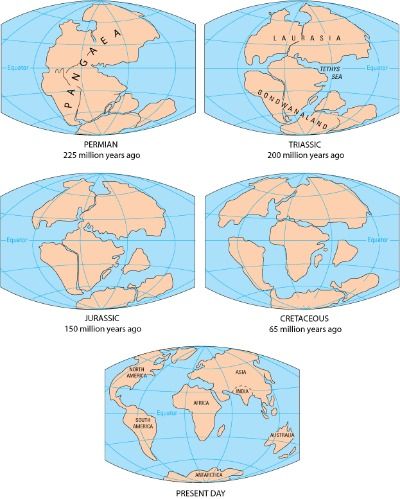
From Pangea to now – image from LiveScience.com
The Permian period was followed by the Triassic, from 250 to 200 mya, fifty million years of nature gone wild (I have that videotape in the attic, I think). Over the course of the Triassic, things on the land started to look like the world we know today. But the continents would have to drift for many millions of years yet before they would resemble our current landmass configuration. The first true dinos showed up around 230 to 240 mya. But they did not have the planet to themselves. There were reptiles, fish, birds, insects, even mammals, small ones, around at the time.
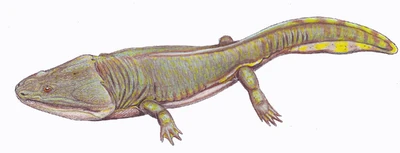
Metoposaurus, Kermit’s g-g-g-g-g-g-g-g-grandma, was an amphibian the size of a Buick, with a coffee-table-sized head, and, unlike those little critters you had to work with in bio lab, these pups had hundreds of very sharp teeth. It hung out by water’s edge to capture anything straying too close. Mostly fish, but watch your ankles.
There is interesting material in here about what came before the dinosaurs, (dinosauromorphs, yes, really) and where the line is drawn (arbitrarily) between dino and pre-dino. You, here, you, over there. Like Middle East borders.
Brusatte walks us through the timeline of the dinos, from conditions being established at the end of the Permian, their arrival in the Triassic, to their sudden farewell at the end of the Cretaceous. Permian, Triassic, Jurassic, Cretaceous. Go ahead, repeat that a few times. It’s the sequence of periods Brusatte covers here. The first three come in at around 50 million years each, with the Cretaceous hanging on for about 80. The last three, taken together, comprise what is known as the Mesozoic Era, aka The Age of the Dinosaurs. (Which makes no sense to me. Shouldn’t it be The Era of the Dinosaurs? Or the Mesozoic Age? It’s so confusing.) He shows what changed geologically, and how the changes allowed this or that lifeform to arise. (often by wiping out the competition). He also takes us along with him to dig sites around the planet, Scotland, Portugal, Poland, The American Southwest, South America, China, and more, and introduces us to some of the foremost scientists in the field.
The characters in Brusatte’s tale are not all of the ancient sort. He populates each chapter with modern specimens notable for their diversity and sometimes colorful plumage. While they may all be brilliant scientists, many could easily be classified as Anates Impar. It would not be a huge stretch to imagine them populating a nerdish Cantina scene. Here are Brusatte’s description of three of them. There are many more.
You can spot Thomas Carr, now a professor at Wisconsin’s Carthage College, from a mile away. He has the fashion sense of a 1970s preacher and some of the mannerisms of Sheldon Cooper from The Big Bang Theory. Thomas always wears black velvet suits, usually with a black or dark red shirt underneath. He has long bushy sideburns and a mop of light hair. A silver skull ring adorns his hand. He’s easily consumed by things and has a long-running obsession with absinthe and the Doors. That and tyrannosaurs.
Thomas Carr – image from his Twitter pageBaron Franz Nopcsa von Felso-Szilvas…was literally an aristocrat who dug up dinosaur bones. He seems like the invention of a mad novelist, a character so outlandish, so ridiculous, that he must be a trick of fiction. But he was very real—a flamboyant dandy and a tragic genius, whose exploits hunting dinosaurs in Transylvania were brief respites from the insanity of the rest of his life…[he had] expertise in espionage, linguistics, cultural anthropology, paleontology, motorbiking, [geology, and god knows what else].
The Baron – image from Albanianphotograpy.comJingmai [O’Connor] calls herself a Paleontologista—fitting given her fashionista style of leopard-print Lycra, piercings, and tattoos, all of which are at home in the club but stand out (in a good way) among the plaid-and-beard crowd that dominates academia…she’s also the world’s number-one expert on those first birds that broke the bounds of Earth to fly above their dinosaur ancestors.
Jingmai O’Connor – image from her Twitter page
Brusatte also shamelessly namedrops every A-list paleontologist he has encountered. Of course, it sounds like those encounters were substantial, so I guess it’s ok, but… I was reminded a bit of Bill Clinton’s memoir, in which it seemed that every person he mentioned had either changed his life or was a close personal friend. In a way, the book constitutes a this-is-your-life look at Brusatte’s paleontology career (boy meets bone?), with appearances by many of the people he had learned from or worked with. (they are legion) In addition to the studies mentioned in the book, he is the author of a widely taught textbook, Dinosaur Paleobiology. He is the paleo expert in residence on Walking with Dinosaurs (so much better than the sequel, Fleeing from Dinosaurs) on the BBC.
One of the things that has allowed modern paleontologists to make and continue to make ground-breaking discoveries about Earth’s former tenants is the major advance in technology at their disposal. It’s a lot easier, for example, to see inside a fossilized skull to measure the size and shape of internal cavities with the help of a CT scanner than it was before they were available.
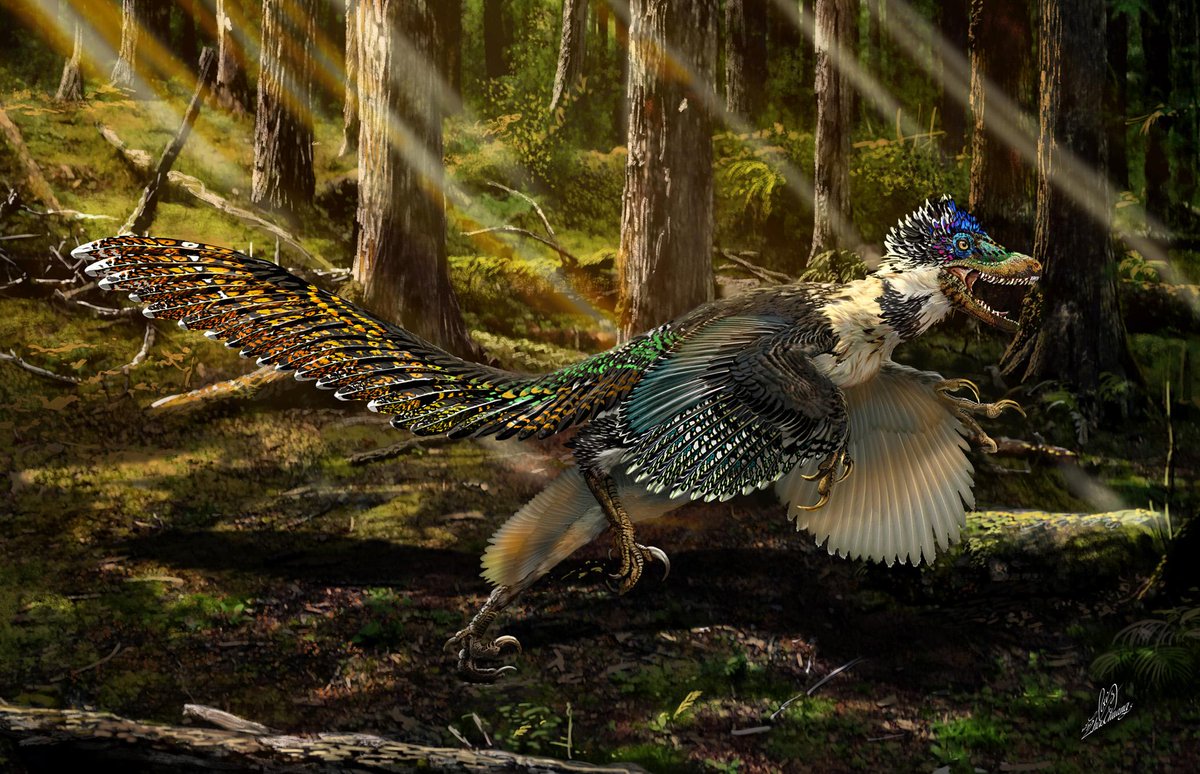
A new dinosaur, feathered, winged Zhenyuanlong from China – image from The Conversation
You will learn some fascinating new information about dinos, some of it startling. This includes how sauropods managed those looooooong necks, why wild diversification happened when it did, why it took dinosaurs as long as it did to get large and take over. There is a fascinating bit on how some dinosaurs can pack an extra punch by getting air while they breathe in and out, surprising intel on how some of the critters you thought were dinosaurs aren’t, and directions on where you can look to see actual living dinosaurs today. He punctures some of the notions from the Jurassic Park movies. If trapped by a T-Rex, for instance, do not remain motionless. Rex has binocular vision and can see you perfectly well, whether you are sitting down in a port-o-san or hiding in or under a vehicle. Wave buh-bye.
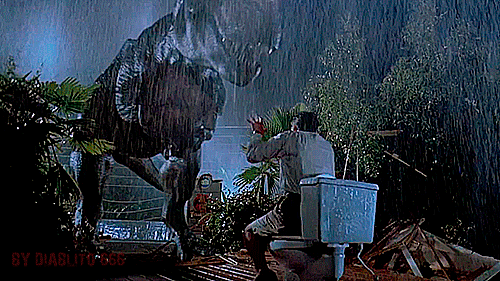
If you do not know what this is from you need to get out more
Speaking of un-fond farewells, Brusatte take us up to and through the biggest bang of them all, on Earth anyway, 66 mya. His description of the horror that marked the end of the dinosaurs is graphic, and disturbing.
It was the worst day in the history of our planet. A few hours of unimaginable violence that undid more than 150 million years of evolution and set life on a new course. T. rex was there to see it.
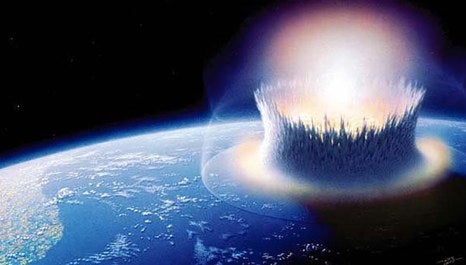
Look, up in the sky. It’s a bird, it’s a plane, it’s…Oh, shit
Artwork by Donald E. Davis
Brusatte has written an eminently readable pop-science history of the dinosaurs, with accessible info on geology, biology, and the work of paleontologists, who are laboring tirelessly (and maybe obsessively) to find out the answers to questions that are as old as humanity’s awareness of the erstwhile inhabitants of our planet. This is one of those books that should be in every household. You do not need to be a scientist to get a lot out of it. The Rise and Fall of the Dinosaurs, bubbling with the enthusiasm of its author, will be an enjoyable and enlightening read for homo sapiens of all ages from pre-teen through fossil. Learning more about Earth’s illustrious, impressive, sometimes terrifying, and sometimes adorable former tenants never gets old. Really, who doesn’t love dinosaurs?
Review posted – April 13, 2018
Publication date – April 24, 2018
December 2018 – Dinosaurs may no longer rule the earth, but The Rise and Fall of the Dinosaurs rules the 2018 Goodreads Choice Award for Science. Reached for comment, a spokesman for Mr. Brusatte offered the following response.
=======================================EXTRA STUFF
Links to the author’s personal and Twitter pages
Episode 37 of Palaeocast features Steve talking about Therapods and Birds – December 1, 2014 – 44:00
A presentation by Brusatte, who is a wonderful speaker, on Tyrannosaur Discoveries, at the U of Edinburgh – Watch this, really. Great stuff.
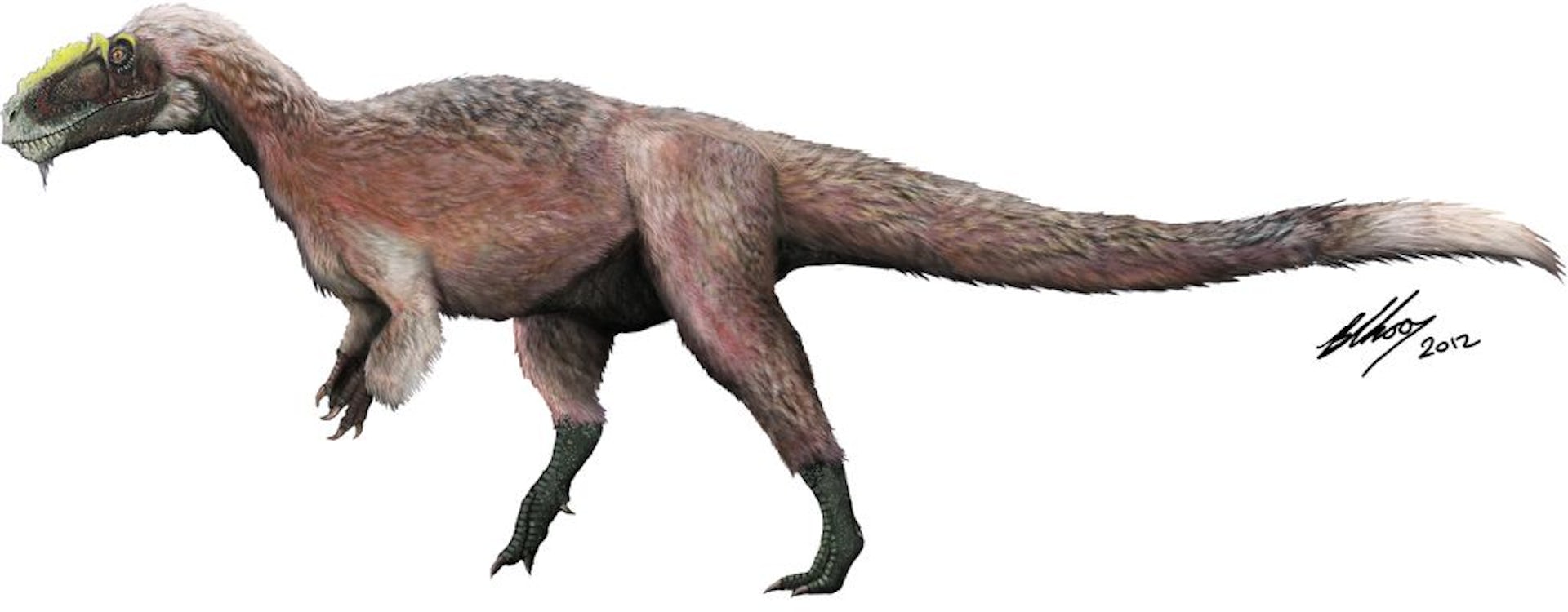
In the above, Brusatte talks about feathered dinos, among other things. Meet Yutyrannus huali, (artist’s interpretation) a feathered tyrannosaur from China (but you can call him Fluffy) – image from The Conversation
A fun article from the BBC – Legendary dinosaurs that we all imagine completely wrong – By Josh Gabbatiss – 3/21/16
NY Times – April 4, 2018 – Brusatte is keeping busy, publishing, with his team, a new study about the presence of dinos in Scotland, specifically in the Isle of Skye. In Footprints on Scotland’s Isle of Skye, Signs of a Dinosaur Playground – by Nicholas St. Fleur

This image of a sauropod print accompanied the above article – from the University of Edinburgh
An interesting lecture (33 minutes) on how paleontologists research dinosaurian social behavior and what they have found – Social Behaviour in Dinosaurs – with David Hone Hone’s delivery has a sing-song rhythm that can be a bit soporific, but the content is fascinating. Of particular interest is the basis for juvenile clustering.
May, 2018 – Smithsonian Magazine – So much is going on in China, paleontologically, not all of it wonderful, as wonderful new resources are found and explored – The Great Chinese Dinosaur Boom – by Richard Conniff

This cluster of dinosaur egg fossils, on display at the Tianyu Museum, dates back 70 million years to the late Cretaceous era – shot by Stefen Chow – text and image from above article
It reminds me of that scene in the first Alien film when they discover the nesting site
—–May 29, 2018 – Check out Ira Flatow’s effervescent review in the NY Times – When the Dinosaurs Reigned
—–June 2, 2018 – National Geographic – Wonderful, informative interview with Brusatte by Simon Worrall – Why Today is the Golden Age for Dinosaur Discoveries
—–December 17, 2018 – Feathers and Fur Fly Over Pterosaur Fossil Finding – By Nicholas St. Fleur
An artist’s rendering of a short-tailed pterosaur from above article – from Yuan Zhang/Nature Ecology & Evolution
—–February 21, 2019 – NY Times – Tiny Tyrannosaur Hints at How T. Rex Became King – by Nicholas St. Fleur

A new species of dinosaur, a tiny relative of the Tyrannosaurus rex, called Moros intrepidus, lived 96 million years ago and its fossils were found in central Utah. – Credit Jorge Gonzalez – image and text from above article
—–March 4, 2019 – NY Times – Tyrannosaurus Rex: The Once and Future King – by James Gorman – a brief summary of upcoming shows, and latest developments on the T-Rex front
—–March 7, 2019 – NY Times – T. Rex Like You Haven’t Seen Him: With Feathers by Jason Farago – on an upcoming exhibit at the American Museum of Natural History

[from above article] A model of a 1-year-old T. rex. Most T. rexes never made it past age 1, but those who did put on up to 140 pounds every month. – Credit George Etheredge for The New York Times
—–June 24, 2019 – Lithub On America’s Wild West of Dinosaur Fossil Hunting – by Lukas Rieppel – an excerpt from his new book
—-January 3, 2020 – NY Times – Beware Tyrannosaurus Rex Teenagers and Their Growth Spurts – by Cara Giaimo – A researcher identifies what was previously thought to have been a separate, smaller species as a younger version of that old favorite – maybe they can call these critters Teen Rex?
—-February 10, 2020 – National Geographic – ‘Reaper of Death’ tyrannosaur discovered in Canada – By Maya Wei-Haas and Michael Greshko – this little guy was only 26 feet long

Image and ff text from NY Times article above – An artist’s impression of Thanatotheristes degrootorum. Some scientists take issue with giving the animal its own distinct genus.Credit…Julius Csotonyi
—–April 15, 2021 – NY Times – How Many Tyrannosaurus Rexes Ever Lived on Earth? Here’s a New Clue. by Kenneth Chang
—–Apr 19, 2021 – Deseret News – Was T. rex a lone wolf or social eater? New research at dig site offers surprising answer by Amy Joi O’Donoghue
—–August 2, 2021 – Smithsonian – Tyrannosaurs Dominated Their Cretaceous Ecosystems by Riley Black
==========================================STUFFING

If you are one of those for whom the reference did not bang a gong, Marc Bolan was the leader of a band named T.Rex. He was one of the progenitors of what was called Glam Rock.
Anates Impar – really? You could not do a Google translate? It means Odd Ducks, ok. Sheesh. Really, don’t make me explain everything again, or I’ll have to take points off your final grade. And if you do not know what “the Cantina scene” is, look it up or don’t come back. Yes, now. Run!

This flamboyantly feathered Rex image is from Deviant Art – Yeah, I doubt it looked like this too, but a fun image I wanted to share
Full disclosure: – Ok, I stole the final line of the review from my illustrious book goddess. I only steal from the best. Thank you, dearest.




